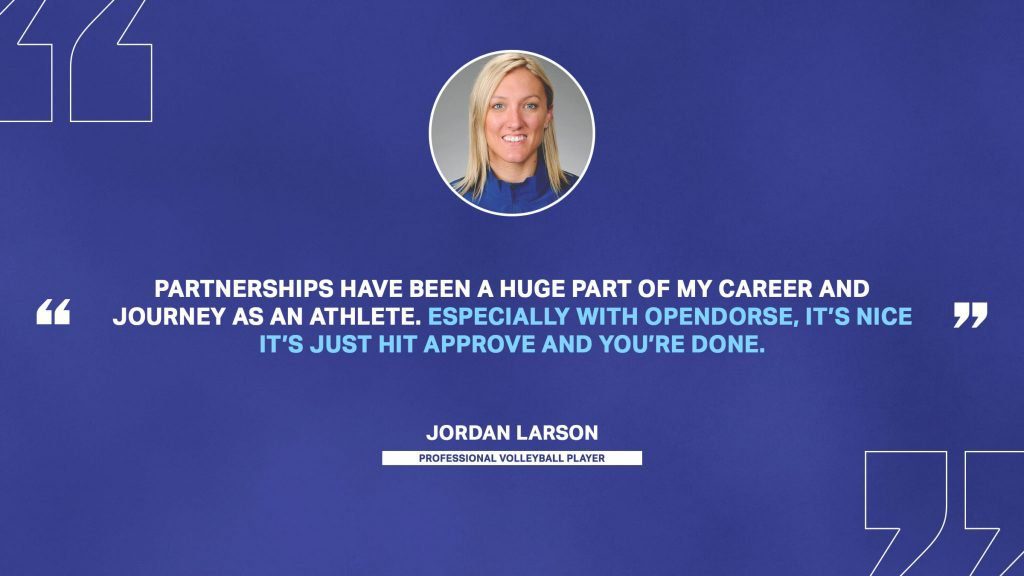Olympic athletes compete at the highest level year-in and year-out to showcase their talents on the global stage every four years. While there are annual competitions for sports like volleyball, swimming, rowing, and track & field, many tend to get buried in broadcasts outside of Olympic years. With this lack of prime-time exposure, social media has become the most consistent avenue for many Olympic athletes to connect with fans.
Balancing Performance, Personal Branding, and Partnerships
To understand how Olympic athletes can build personal brands and secure partnerships, we caught up with two-time Olympic volleyball medalist and former All-American and NCAA champion with Nebraska Volleyball, Jordan Larson. Representing Team USA for the past ten years, Jordan has experienced first-hand the benefits of brand partnerships and endorsements for Olympic Athletes.
“Partnerships have allowed me to be a better professional athlete. I’ve had all of these services either gifted to me and am able to have these great brands. Obviously, the financial component is setting me up for financial gain, but I’m also able to give back to my followers and people who are committed fans. It allows for that interaction and has allowed for my fans to either win things or participate in giveaways and things like that.”

Olympians like Larson have the opportunity to build extremely engaged audiences in their sport’s niche. These athletes can use that to their advantage to promote a variety of brands that are closely tied to their sport.
For example, volleyball players might earn opportunities with sport-specific brands like Mizuno, while promoting products that also relate to their audience’s everyday lives such as shoe insoles and meal preparation services.
But how exactly do athletes build relationships with brand partners and get a deal done?
Larson says, “Most of the time people are reaching out to me, wanting me to represent their brand. Which is great and it leads to a lot of good conversations to leverage in other areas. But there are also times there’s been things like Evolve (a meal preparation service), where I reached out to them and was like, ‘Hey I really like your product. I’m looking into something like this. Is this something you guys would want to collaborate on?’”
Evolve is an example of a partnership that has greatly benefited both parties. With Jordan’s busy training schedule, she rarely has time to prepare a healthy meal after practice, but requires the vital nutrients elite performance demands. Evolve sends her product and Larson posts about it on social media; a natural partnership that fits into her lifestyle and the brand’s goals.
The lifestyle of an Olympic athlete can be impossibly busy. With daily practice, lifting, recovery, and partnership obligations, social media can easily be overlooked as a priority.
“Don’t get me wrong, social media adds a lot of value. But putting it in perspective, my end goal was wanting to be an Olympian and I was going to do whatever that took. I think my work ethic is what really helped create my brand and set me apart. I was able to communicate that through social media channels and show I’m doing this, and doing this, and being active in that manner, which felt very authentic to me.”
Unlike professional influencers and creators, athletes aren’t required to pour in time and resources to receive value from social media. Fans want authenticity and insight into an athlete’s unique and busy lives. Audiences will grow and partnerships will come naturally, but for many, the hardest part is simply remembering to post.
Larson says, “I wouldn’t say I’m great at having a very cohesive look on my social channels, but I try to keep it as up to date as I can with information. But partnerships have been a huge part of my career and journey as an athlete. Especially with Opendorse, it’s nice it’s just hit approve and you’re done.”
How NIL will Impact Olympic Sports?
Jordan has experienced the rise of social media and has experienced its benefit to her athletic career. As student-athlete compensation rule changes come to the NCAA level in 2021, athletes competing in Olympic sports while at the collegiate level will likely be allowed to benefit from their name, image, and likeness rights.
These sports are often overlooked as non-revenue generating programs, and have limited or professional opportunities after college. But with NIL, these athletes will soon be able to benefit from the personal brands and local recognition they create while on campus. From social media endorsements and in-person promotions, to camps and lessons, there will be opportunities to earn compensation for athletes at every level.
“I think it’s going to be huge. It’s going to be great for the athletes because they’re going to reap some benefit from their NIL and finally see some of that. I just hope it doesn’t take away from the authenticity and the amateur feeling of playing.”
College athletics can already feel like two full-time jobs.
Larson says of her playing days, “I’m thinking back to my college days and was like… When would I have time to go and do an interview? It was very rare. Like, it was a post-practice interview and that was it. I’d have to go recover and then do things for the next day. I just hope that it’s not a distraction and that it only adds value where it should. And I think it should, but there’s a fine line.”
In the end, Larson says “I definitely think [NIL] would have had an impact. At Nebraska, volleyball is very popular and the image of those athletes is very well known in the state. I can imagine there are a lot of people that would want them to promote their companies.”
Larson’s biggest piece of advice to any athlete who is looking to grow their brand:
“As long as you stay true to yourself and what those goals are: the followers will come.”




